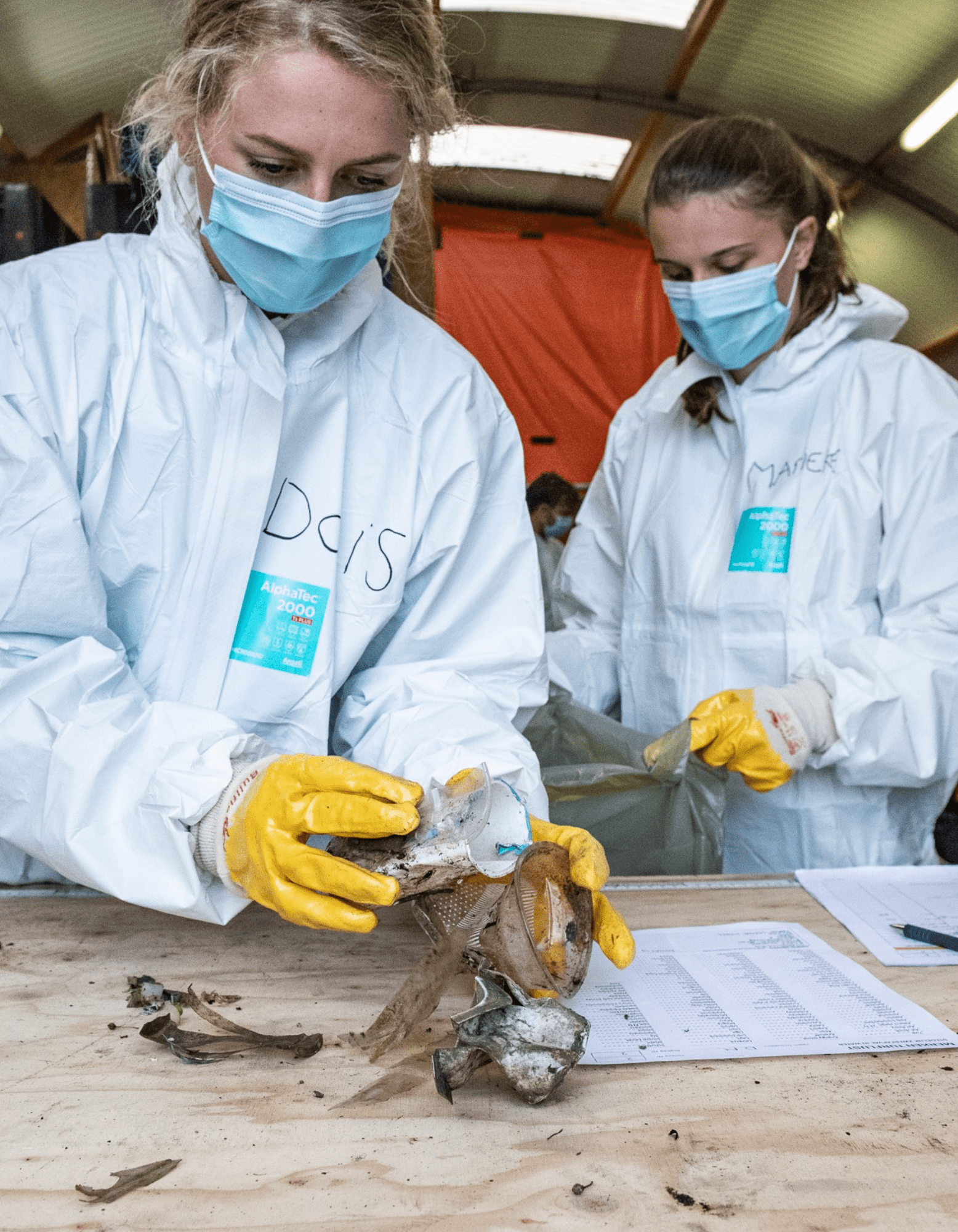The Problem
River Plastic Pollution
Every year, 5.8 million tonnes of plastic waste enter our rivers, with small urban rivers contributing the most to the outflow to the ocean. This pollution threatens health, disrupts water quality, and damages infrastructure. The problem needs to be tackled today, in our rivers.
tonnes of plastic
enter rivers every year*
%
of all plastic waste ends up in our environment each year**
years
is the estimated time a plastic bottle takes to decompose in the marine environment***
* Ospar ** NOAA *** WEF
FROM LOCAL TO GLOBAL
Plastic soup in rivers
When plastic enters waterways, the resulting problem becomes twofold. First, rivers and canals transport plastic pollution to the ocean and contribute to plastic soup(s). Second, rivers act as plastic reservoirs, trapping plastic for years, decades, and potentially centuries.
The longer plastic remains in our environment, the more damage it can do to ecosystems, wildlife, and our health. It is essential that the plastic soup in rivers is tackled close to the source. In that way, we minimise damage and prevent plastic from eventually ending up in the ocean.
Wildlife & Ecosystems
Wildlife often mistake plastic for food and end up ingesting plastic, suffocating by it or getting entangled in it, often leading to suffering and eventually death.
Human Health
Microplastics are found in our tap water, beer, salt and in the air we breathe. Several chemicals used to produce plastic are carcinogenic and interfere with the body’s endocrine system.
SHIPPING & TRANSPORT
Plastics can become entangled in propellers or be sucked into water intakes. If these issues go unnoticed, they can lead to engine overheating and complete failure, resulting in costly repairs.
The problem of river plastic pollution
What is plastic?
Plastics are a group of synthetic and semi-synthetic materials made from polymers mostly derived from fossil fuels. They are light, versatile, water-resistant and cheap. They are soft and malleable when warm, but harden as they cool, and can be formed into various shapes, and easily coloured. Over the past 100 years since their invention, plastics have been formed into everything from crisp packets to bottles, suitcases and even bank notes.
What is the problem with plastic?
A forever issue
Plastics do not decompose like organic materials. Instead, they break down into smaller pieces called microplastics, a process that can take up to 1,000 years to complete. During this breakdown, toxic chemicals are released, which can harm the environment.
Many plastics cannot be recycled, and even when recycling is possible, new or virgin plastics are often cheaper to produce than recycled plastics. As a result, only 9% of all plastics ever produced have been recycled. Because plastic is lightweight, even waste that is disposed of properly can blow out of bins and end up in our rivers or oceans.
This situation has led to a significant and growing pollution problem. Nearly 6 million tonnes of plastic enter our rivers each year. In addition to causing issues in rivers, plastics also make their way to the ocean, contributing to the problem of plastic soup.
What is the cost of plastic pollution?
Damage to ecosystems
- Plastic pollution is immensely harmful to wildlife. Marine animals such as whales, turtles, and seabirds often mistake plastic for food; for instance, a floating plastic bag can resemble a jellyfish. When they ingest plastic, it fills their stomachs, leaving no room for their natural diet, which leads to devastating consequences.
- Toxic chemicals from plastics contaminate the land, disrupting habitats and natural processes. This contamination directly impacts food production and the ability of ecosystems to adapt to climate change.
- Humans ingest between 553 and 883 pieces of microplastic daily through drinking water, fish consumption, and crops grown in contaminated soil. Plastics have been detected in human blood, breast milk, and the placenta.
The growing cost of clean-up
- According to one study, the annual cost of cleaning up beaches just along the west coast of the USA was in the region of $500 million. The annual global economic loss due to plastic pollution is estimated at an astronomical €5-18 billion. Worldwide, plastic pollution has a massive impact on our communities and livelihoods.
- The total cost of plastic pollution has been estimated at $3.7 trillion, which is larger than the economy of India. Furthermore, these costs are projected to double over the next 20 years.
Damage to vessels and infrastructure
- Plastic pollution damages boats. Plastic bags can become entangled in propellers or be sucked into water intakes. If these issues go unnoticed, they can lead to engine overheating and complete failure, resulting in costly repairs.
What can we do to stop plastic pollution?
Reduce, Reuse, Recycle
One of the simplest and most effective ways to limit plastic pollution is to reduce the amount of plastic we buy and use. This can include purchasing unpackaged vegetables, using a refillable water bottle, or switching to plastic-free cosmetics. It’s also important to be aware of hidden plastics found in items like synthetic clothing or menstrual products.
When we cannot completely eliminate plastic, we should aim to reuse it for as long as possible. Once plastic reaches the end of its life, we should recycle as much of it as we can.
Clean-up and activism
Unfortunately, plastics end up in the environment. Timely clean-up efforts are essential to minimise its negative impacts. We can participate in local river or beach clean-ups and advocate for companies to reduce plastic in their products and packaging. We can also urge politicians to implement regulations on plastic use.
Community action is powerful. Several communities have initiated the installation of Bubble Barriers in their rivers, helping to clean waterways. The mission of The Great Bubble Barrier is to stop plastic pollution closer to the source before it flows into our oceans. Campaigning for a Bubble Barrier in your community can contribute to the clean-up of rivers.
Can we recycle river plastic?
The current situation
Only 9% of all plastics ever created have been recycled to this date. Effective plastic recycling of ‘regular’ household waste already poses significant obstacles due to costs, regulation and technical complexities. Recycling river plastic brings even more challenges.
When riverine plastic is collected, it is often mixed with organic material and the surface of the plastic is covered with biofouling or organic matter. This complicates sorting the plastic effectively. Besides that, river plastic is often of a ‘lower grade’, because it quickly breaks down into smaller pieces as a result of UV exposure and weathering.
Besides these technical challenges, legislation around the post-consumer use of plastics doesn’t always provide a good business case for collecting, sorting and cleaning plastic for recycling. A truly circular use of plastic is still not available on a large scale, in part because of high costs, regulations and technical complexities.
A circular future
Even though the challenges with recycling river plastic might be discouraging, this does not stop The Great Bubble Barrier from spending time and effort on finding the right recycling partners for the waste our Bubble Barriers capture in rivers. Together with these partners, we are continuously challenging the status quo of plastic recycling.
Read our article to learn more about plastic recycling.
MONITORING RIVER PLASTIC
What exactly flows through our waterways?
There is limited data available on what specifically flows through our rivers and canals. Research has shown concerning trends when it comes to the state of rivers, lakes, and estuaries, for example in Europe, where the majority fall below minimum environmental standards.
To address this issue more effectively, it is essential to monitor plastic pollution levels. This can be done through riverbank clean-ups, citizen science initiatives, and technologies like Bubble Barriers. By gathering more insights through research, policymakers will be better equipped to take urgent action to prevent plastic pollution.
Ready to learn more?
We have carefully researched plastic pollution and effective solutions to tackling it. Read our articles and whitepapers on a range of topics.



